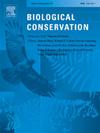Indigenous land is the keystone to protecting Brazilian bat (Mammalia: Chiroptera) biodiversity and their ecosystem services
IF 4.9
1区 环境科学与生态学
Q1 BIODIVERSITY CONSERVATION
引用次数: 0
Abstract
Global biodiversity is under unprecedented threat from anthropogenic activities, particularly in tropical regions that harbor high concentrations of endemic species. Bats, as key ecological players in tropical ecosystems, provide essential services such as pollination, seed dispersal, and pest control, yet many species face significant threats due to habitat loss and degradation. This study evaluates the role of Indigenous Lands (TIs) and Protected Areas (PAs) in conserving bat biodiversity and their ecosystem services in Brazil. Using species distribution models (SDMs) and the Zonation algorithm, we assessed the conservation importance of 179 bat species across different trophic guilds and IUCN threat categories. Our findings reveal that TIs, though not originally designated for biodiversity conservation, play a crucial role in preserving bat habitats. However, current PAs show low importance to protect bat diversity, particularly for species with restricted distributions or those in highly threatened biomes like the Atlantic Forest, Cerrado, and Caatinga. The Amazon biome, despite its extensive network of PAs, faces increasing threats from illegal activities, underscoring the need for integrated conservation strategies that include ILs and private lands. We highlight the urgent need for conservation policies grounded in ecological priorities rather than economic or political motivations. Expanding protected areas in critical biomes and incorporating Tis in conservation planning are essential steps to safeguard bat biodiversity and the ecosystem services they provide.
土著土地是保护巴西蝙蝠(哺乳目:翼目)生物多样性及其生态系统服务的基石
全球生物多样性正受到人类活动前所未有的威胁,特别是在特有物种高度集中的热带地区。蝙蝠作为热带生态系统中重要的生态参与者,提供授粉、种子传播和病虫害防治等基本服务,但由于栖息地丧失和退化,许多物种面临重大威胁。本研究评估了巴西土著土地(TIs)和保护区(PAs)在保护蝙蝠生物多样性及其生态系统服务中的作用。采用物种分布模型(SDMs)和Zonation算法,对179种不同营养行会和IUCN威胁类别的蝙蝠物种的保护重要性进行了评估。我们的研究结果表明,尽管最初不是为生物多样性保护而指定的,但在保护蝙蝠栖息地方面起着至关重要的作用。然而,目前的保护区对保护蝙蝠多样性的重要性较低,特别是对于那些分布有限或处于大西洋森林、塞拉多和卡廷加等高度受威胁生物群落中的物种。亚马逊生物群落尽管拥有广泛的保护区网络,但面临着越来越多的非法活动威胁,这凸显了包括保护区和私人土地在内的综合保护战略的必要性。我们强调迫切需要以生态优先而不是经济或政治动机为基础的保护政策。扩大关键生物群系的保护区并将其纳入保护规划是保护蝙蝠生物多样性及其提供的生态系统服务的必要步骤。
本文章由计算机程序翻译,如有差异,请以英文原文为准。
求助全文
约1分钟内获得全文
求助全文
来源期刊

Biological Conservation
环境科学-环境科学
CiteScore
10.20
自引率
3.40%
发文量
295
审稿时长
61 days
期刊介绍:
Biological Conservation is an international leading journal in the discipline of conservation biology. The journal publishes articles spanning a diverse range of fields that contribute to the biological, sociological, and economic dimensions of conservation and natural resource management. The primary aim of Biological Conservation is the publication of high-quality papers that advance the science and practice of conservation, or which demonstrate the application of conservation principles for natural resource management and policy. Therefore it will be of interest to a broad international readership.
 求助内容:
求助内容: 应助结果提醒方式:
应助结果提醒方式:


